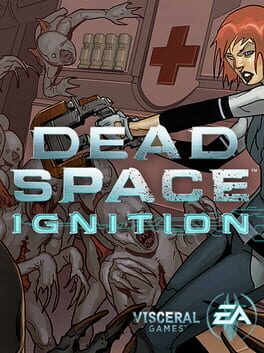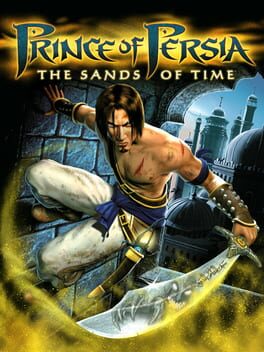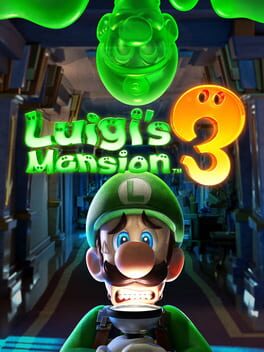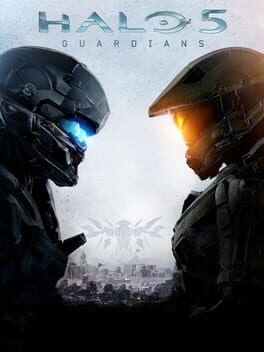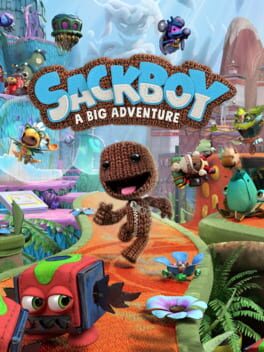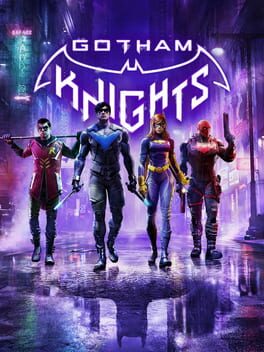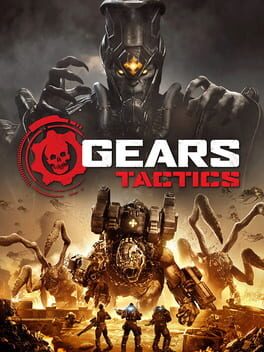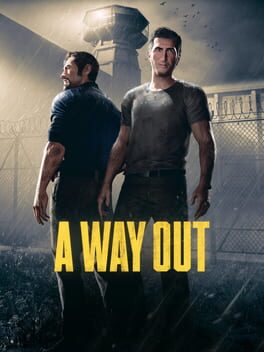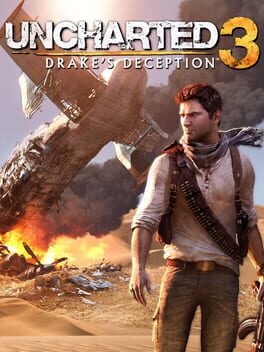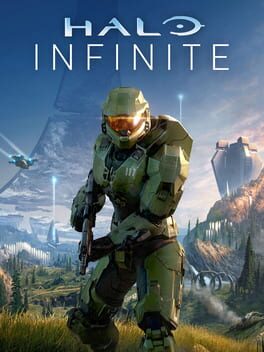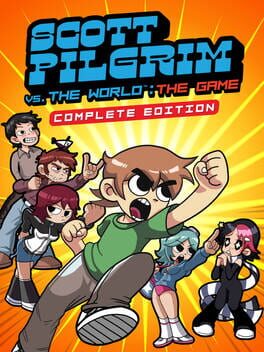Granny7989
2010
Being a game released in 2003, I had a lot of fun working out the platforming puzzles without modern design that obviously highlights what and where you should climb. The hint system does enough to prod you in the right direction without the game outright holding your hand. The dagger of time alleviates some of the fatal mistakes by allowing you to rewind time and have another ago, assuming you have enough sand to do so.
However, the combat was the single biggest point of frustration for me. While the combat is serviceable when dealing with a handful of enemies, there are five or six instances where the game will force you into combat challenges where you need to deal with wave after wave of enemies. As these combat challenges usually happen in small rooms, the enemies will easily gang up on you, knock you down, letting the other enemies continuously deal damage, before you have the chance to get up and block/dodge their attacks.
It's because of these moments that I will never pick this game up ever again.
However, the combat was the single biggest point of frustration for me. While the combat is serviceable when dealing with a handful of enemies, there are five or six instances where the game will force you into combat challenges where you need to deal with wave after wave of enemies. As these combat challenges usually happen in small rooms, the enemies will easily gang up on you, knock you down, letting the other enemies continuously deal damage, before you have the chance to get up and block/dodge their attacks.
It's because of these moments that I will never pick this game up ever again.
I played The Callisto Protocol with a lot of quality-of-life patches applied to the game. While I had an okay time with the game, it’s not often I play a game that make me feel a lot of potential had been squandered.
The visual presentation seems to be where most of the time and effort has gone into the game. The graphical fidelity and animation are some of the best that I have seen for the 9th generation of games. The detail of the facial features and animation is excellent, and I believe The Callisto Protocol has set a new bar of technical quality that other games should aspire for.
I did like the game went for a melee brawler combat system rather than opting for the over-the-shoulder shooter that has been done so many times now. I know some people had issues with the combat system, but I found it worked fine for the most part, most likely due to the patches that were released for the game. I liked that you had to use the left stick to dodge enemy attack and wait for an opening to bonk them on the head with the stand baton.
Sadly, the gameplay loop doesn’t evolve beyond hitting zombies with your baton and occasionally shooting them with your sidearm. Most zombies you’ll come across are human like, so combat encounters will work the same regardless of what you are fighting.
The art design feels uninspired. You’ll navigate through medical wings, prison cells, hydroponics centres, and mining towns. However, with everything being so dark and the walls being covered in metal and pipework, the levels rarely feel distinct from one another.
Levels are linear in their design. Being linear isn’t really the problem. The issue I had that, while the levels themselves can be very detailed, there was very little reason to explore the immediate environment that you were in. There’s rarely any loot that is hidden away in a nook somewhere. You do occasionally come across optional route that will lead you to a loot chest but it’s never clear if the path you’re on is the main path or the optional one.
The story is nothing to write home about. You’ll probably guess where the story is going after the first hour of playing. You’ll collect audio logs to get more backstory on what’s going on but even they are not worth listening to. It’s not like the original Dead Space or System Shock 2 where you’re piecing together the story of the events that happened have occurred before. The audio logs could be completely omitted from the game and the very little would have been lost from the removal.
My review probably gives the impression that I had a terrible time with the game but that’s not the case; the game is fine, but it should have been a solid first entry to a new series in the action-horror genre. It is a difficult game for me to recommend to others to play, at least as a full price game. The takes around 10 hours to complete, so if you see it bundled as part of PlayStation Plus or Xbox Game Pass, or you see it going cheap on a sale, I think it’s worth giving it a go.
The visual presentation seems to be where most of the time and effort has gone into the game. The graphical fidelity and animation are some of the best that I have seen for the 9th generation of games. The detail of the facial features and animation is excellent, and I believe The Callisto Protocol has set a new bar of technical quality that other games should aspire for.
I did like the game went for a melee brawler combat system rather than opting for the over-the-shoulder shooter that has been done so many times now. I know some people had issues with the combat system, but I found it worked fine for the most part, most likely due to the patches that were released for the game. I liked that you had to use the left stick to dodge enemy attack and wait for an opening to bonk them on the head with the stand baton.
Sadly, the gameplay loop doesn’t evolve beyond hitting zombies with your baton and occasionally shooting them with your sidearm. Most zombies you’ll come across are human like, so combat encounters will work the same regardless of what you are fighting.
The art design feels uninspired. You’ll navigate through medical wings, prison cells, hydroponics centres, and mining towns. However, with everything being so dark and the walls being covered in metal and pipework, the levels rarely feel distinct from one another.
Levels are linear in their design. Being linear isn’t really the problem. The issue I had that, while the levels themselves can be very detailed, there was very little reason to explore the immediate environment that you were in. There’s rarely any loot that is hidden away in a nook somewhere. You do occasionally come across optional route that will lead you to a loot chest but it’s never clear if the path you’re on is the main path or the optional one.
The story is nothing to write home about. You’ll probably guess where the story is going after the first hour of playing. You’ll collect audio logs to get more backstory on what’s going on but even they are not worth listening to. It’s not like the original Dead Space or System Shock 2 where you’re piecing together the story of the events that happened have occurred before. The audio logs could be completely omitted from the game and the very little would have been lost from the removal.
My review probably gives the impression that I had a terrible time with the game but that’s not the case; the game is fine, but it should have been a solid first entry to a new series in the action-horror genre. It is a difficult game for me to recommend to others to play, at least as a full price game. The takes around 10 hours to complete, so if you see it bundled as part of PlayStation Plus or Xbox Game Pass, or you see it going cheap on a sale, I think it’s worth giving it a go.
2019
Luigi's Mansion 3 is bursting with charm and personality that I've come to expect from this series. While the gameplay largely remains the consistent throughout, use your torch to stun ghosts and then suck them up with your vacuum, each level of the hotel has a unique theme and end boss that made me eager to progress to see what the game offered next.
Despite thoroughly enjoying Luigi's Mansion 3, there were a few things that were a let down, which can be summed up as a lack of polish I come to expect from Nintendo. Controlling Luigi can be fiddly at times, especially when trying to reoriente Luigi while charging his torch to stun ghosts with. A couple of the puzzles required me to look up a solution online; I knew what I had to do to solve it but I didn't know what interaction the game was expecting from me. There's a jump in difficulty when it comes to the final two bosses that may catch some people out, after having 15 hours of consistent low challenge.
Overall, I had a lot of fun with Luigi's Mansion 3 and I would recommend to the majority of Switch owners. If you missed out on the excellent Luigi's Mansion 2 on the 3DS, you'll get a very similar experience that those players got with this game.
Despite thoroughly enjoying Luigi's Mansion 3, there were a few things that were a let down, which can be summed up as a lack of polish I come to expect from Nintendo. Controlling Luigi can be fiddly at times, especially when trying to reoriente Luigi while charging his torch to stun ghosts with. A couple of the puzzles required me to look up a solution online; I knew what I had to do to solve it but I didn't know what interaction the game was expecting from me. There's a jump in difficulty when it comes to the final two bosses that may catch some people out, after having 15 hours of consistent low challenge.
Overall, I had a lot of fun with Luigi's Mansion 3 and I would recommend to the majority of Switch owners. If you missed out on the excellent Luigi's Mansion 2 on the 3DS, you'll get a very similar experience that those players got with this game.
The Force Unleashed is a game that I wish was more of an evolution of the Jedi Outcast/Jedi Academy games. While it was fun to lift up Stormtroopers to torment them, using the Force as a weapon was more difficult than it should have been. No matter how far I played through the game, I always seemed to struggle to get thrown objects to hit the targets I am aiming for. Sometimes my Force lightning will arc out and hit multiple foes, other times will just target a single enemy despite being part of a group.
The story feels like it was written by a horny 14-year-old going through an edgy phase. Many of the worlds that you visit are grim and dark. Juno Eclipse wears her uniform in such a way to show off flesh to (bonk!) send our protagonist to horny jail when first laying eyes on her, and she gets no further development after that. Even the name “Starkiller” makes me roll my eyes roll. I don’t care much about the Star Wars canon these days but the sheer power the Starkiller is able to demonstrate gets the point of ridiculousness. Pulling a Star Destroyer from the sky and crashing it to the ground looks cool in cutscenes but then it makes me wonder why Starkiller can’t use that level of power while playing the actual game.
Despite my issues with the game, I did have a fun time replaying it. There’s something satisfying about blasting open a door with Force push and shocking everyone to death. Despite the grim look of the environments, the levels are varied enough to keep things fresh and interesting. Some levels incorporate the use of Force powers to create openings or platforms to progress. While almost every boss is some type of lightsaber wielder, each one requires different tactics to bring them down.
While The Force Unleashed won’t be in my personal top 10 list of favourite Star Wars games, the way the Force has been given life in the form of a physics engine, as well as being easily accessible on PC and Xbox, makes it worth checking out by those who might be curious.
The story feels like it was written by a horny 14-year-old going through an edgy phase. Many of the worlds that you visit are grim and dark. Juno Eclipse wears her uniform in such a way to show off flesh to (bonk!) send our protagonist to horny jail when first laying eyes on her, and she gets no further development after that. Even the name “Starkiller” makes me roll my eyes roll. I don’t care much about the Star Wars canon these days but the sheer power the Starkiller is able to demonstrate gets the point of ridiculousness. Pulling a Star Destroyer from the sky and crashing it to the ground looks cool in cutscenes but then it makes me wonder why Starkiller can’t use that level of power while playing the actual game.
Despite my issues with the game, I did have a fun time replaying it. There’s something satisfying about blasting open a door with Force push and shocking everyone to death. Despite the grim look of the environments, the levels are varied enough to keep things fresh and interesting. Some levels incorporate the use of Force powers to create openings or platforms to progress. While almost every boss is some type of lightsaber wielder, each one requires different tactics to bring them down.
While The Force Unleashed won’t be in my personal top 10 list of favourite Star Wars games, the way the Force has been given life in the form of a physics engine, as well as being easily accessible on PC and Xbox, makes it worth checking out by those who might be curious.
2015
Halo 5: Guardians feels like a game with an identity crisis; while 343i is putting their own mark on the franchise, instead of rehashing the same thing that Bungie has done with Halo for nine years, but also not getting what made the games resonate with fans so well.
There as some good things about the game. As you are always playing in a squad with three other AI-controlled Spartans by your side, Halo 5: Guardians give the player the ability to issue commands to your team; you can order them to move to a specific area, attack a specific enemy, pick up a certain weapon, heal you, etc. This command feature was something that I wish I had when playing Halo: Reach, a game where you supposed to be one member of a team but the game did very little to make you feel that you were part of a coordinated team.
The Promethean weapons, something that was a frequent complaint of being underwhelming to use, have been tweaked to make them a much more viable option in combat, even on harder difficulty levels.
The game also runs at a 60 frames per second. With the inclusion of the dynamic resolution, the action always remains at a silky smooth frame rate no matter how much action appears on screen.
However, Halo 5: Guardians is riddled with many problems that more or less persist from start to finish. You’re frequently bouncing from one planet to the next with each level, so you don’t get a real feel for the setting that you’re in before whisked away to some place different. The levels themselves, aside from a couple that I quote enjoyed, lack the interesting level design that I had come to expect from the franchise.
A gameplay tweak added to Halo 5: Guardians is the ability to use site-aim on nearly every weapon in the game, something that those who are versed in the Call of Duty series will be familiar with. While I don’t find this a problem in of itself, it’s an odd addition to make for the game that I never felt was needed, which further muddies the series identity. Is 343i trying to modernise the Halo franchise in a way that brings it up along with other modern first person shooters today? Or is 343i trying to entice the Call of Duty crowd over with features that they will be comfortable with.
The presentation seems to be all over the place too. Cutscenes feel that they’re only there to give the player the least amount of plot before awkwardly fading to black. I’m unsure if this is a result of running out of time or budget or a result of the story being reworked or a combination of the three. The game also features talented actors, such as Laura Bailey and Nathan Fillion, but they’re barely present in the story or gameplay that it makes you wonder why 343i went to the effort to hire such talent.
Along with the presentation issues with the story itself; the story does a very poor job of establishing the characters, the setting, and the stakes. There are some interesting themes that are brought up in the story, such as rebuilding in a post galactic war time where resuming your old life might bring back old tensions between independent living and the threat of government overreach, the idea of artificial intelligence being used to govern a colony, even though that AI is slowly breaking down, and the changing face of allies and enemies. All of these themes are never given any time to be fully fleshed out and explored before being binned and something else is brought to the forefront of the story. It’s like the developers couldn’t decide what kind of story they wanted to tell, so they mashed all their ideas into one game, making it come across as diluted as a result.
As a result of the messy presentation and story, it can be hard to really get a grasp on the urgency of the events that are unfolding before you, which makes it difficult to get invested. I never really held the stories in previous Halo games with any esteem but I always had a good idea of the setting I was in, the characters that I was with, and the stakes that were presented before me.
Halo 5: Guardians is not a bad game; I still had fun with the game despite the issues. However, Halo 5: Guardians isn’t a particularly good game, which is a problem for a first-party Microsoft title for the Xbox One. This is a game that I can only recommend to those who have a gap in their library and the game is going cheap in the Microsoft Store. I can only envision myself replaying this game if I were doing a run through the entire series from start to finish. Halo 5: Guardians is a game that doesn’t know what it wants to be; does it want to a Halo game or does it want to be like every other modern day shooter that was coming out in the mid-2010s?
There as some good things about the game. As you are always playing in a squad with three other AI-controlled Spartans by your side, Halo 5: Guardians give the player the ability to issue commands to your team; you can order them to move to a specific area, attack a specific enemy, pick up a certain weapon, heal you, etc. This command feature was something that I wish I had when playing Halo: Reach, a game where you supposed to be one member of a team but the game did very little to make you feel that you were part of a coordinated team.
The Promethean weapons, something that was a frequent complaint of being underwhelming to use, have been tweaked to make them a much more viable option in combat, even on harder difficulty levels.
The game also runs at a 60 frames per second. With the inclusion of the dynamic resolution, the action always remains at a silky smooth frame rate no matter how much action appears on screen.
However, Halo 5: Guardians is riddled with many problems that more or less persist from start to finish. You’re frequently bouncing from one planet to the next with each level, so you don’t get a real feel for the setting that you’re in before whisked away to some place different. The levels themselves, aside from a couple that I quote enjoyed, lack the interesting level design that I had come to expect from the franchise.
A gameplay tweak added to Halo 5: Guardians is the ability to use site-aim on nearly every weapon in the game, something that those who are versed in the Call of Duty series will be familiar with. While I don’t find this a problem in of itself, it’s an odd addition to make for the game that I never felt was needed, which further muddies the series identity. Is 343i trying to modernise the Halo franchise in a way that brings it up along with other modern first person shooters today? Or is 343i trying to entice the Call of Duty crowd over with features that they will be comfortable with.
The presentation seems to be all over the place too. Cutscenes feel that they’re only there to give the player the least amount of plot before awkwardly fading to black. I’m unsure if this is a result of running out of time or budget or a result of the story being reworked or a combination of the three. The game also features talented actors, such as Laura Bailey and Nathan Fillion, but they’re barely present in the story or gameplay that it makes you wonder why 343i went to the effort to hire such talent.
Along with the presentation issues with the story itself; the story does a very poor job of establishing the characters, the setting, and the stakes. There are some interesting themes that are brought up in the story, such as rebuilding in a post galactic war time where resuming your old life might bring back old tensions between independent living and the threat of government overreach, the idea of artificial intelligence being used to govern a colony, even though that AI is slowly breaking down, and the changing face of allies and enemies. All of these themes are never given any time to be fully fleshed out and explored before being binned and something else is brought to the forefront of the story. It’s like the developers couldn’t decide what kind of story they wanted to tell, so they mashed all their ideas into one game, making it come across as diluted as a result.
As a result of the messy presentation and story, it can be hard to really get a grasp on the urgency of the events that are unfolding before you, which makes it difficult to get invested. I never really held the stories in previous Halo games with any esteem but I always had a good idea of the setting I was in, the characters that I was with, and the stakes that were presented before me.
Halo 5: Guardians is not a bad game; I still had fun with the game despite the issues. However, Halo 5: Guardians isn’t a particularly good game, which is a problem for a first-party Microsoft title for the Xbox One. This is a game that I can only recommend to those who have a gap in their library and the game is going cheap in the Microsoft Store. I can only envision myself replaying this game if I were doing a run through the entire series from start to finish. Halo 5: Guardians is a game that doesn’t know what it wants to be; does it want to a Halo game or does it want to be like every other modern day shooter that was coming out in the mid-2010s?
Sackboy: A Big Adventure obviously takes inspiration from Nintendo's Super Mario 3D World, from the level variety to the stickers that you collect at the end of each level. Unfortunately, Sackboy is a game that I found to be a mixed bag of quality.
The jumping mechanics feel underdeveloped and often too shallow to be effective. I would frequently fall short of an enemy I'm trying to hit on the head and end up in the enemy's reach to attack me. Or I would fall into a pit, leading to my death.
This wouldn't be so much of an issue if the game didn't insist on punishing the player twice for dying. The first punishment is losing out on earning the "Ace" level medal, earned by completing a level without losing a life. However, the game will also punish the player by removing 10% of the total orbs that have been collected in the level. If a player was trying to earn the gold medal for collecting a specific number of orbs in a level, and they were to die near the end, a 10% reduction could potentially cost the player that medal, forcing a level restart.
However, there are levels that feel like a lot of thought and creativity has been put in by the developers. When the level design works with the limited jumping mechanics, the game can be a lot of fun. The most memorable levels are the ones that play along to a licenced music track.
I think there’s a lot of potential for the Sackboy franchise. If there’s only one thing I want in a sequel, it would be to make the game as polished as a Mario title. If you’re a PlayStation owner who always wanted to have a 3D platformer like Mario, you'll definitely have a fun time. However, if you’ve played a Mario title released within the last 10 years, you may find Sackboy a bit lacking.
The jumping mechanics feel underdeveloped and often too shallow to be effective. I would frequently fall short of an enemy I'm trying to hit on the head and end up in the enemy's reach to attack me. Or I would fall into a pit, leading to my death.
This wouldn't be so much of an issue if the game didn't insist on punishing the player twice for dying. The first punishment is losing out on earning the "Ace" level medal, earned by completing a level without losing a life. However, the game will also punish the player by removing 10% of the total orbs that have been collected in the level. If a player was trying to earn the gold medal for collecting a specific number of orbs in a level, and they were to die near the end, a 10% reduction could potentially cost the player that medal, forcing a level restart.
However, there are levels that feel like a lot of thought and creativity has been put in by the developers. When the level design works with the limited jumping mechanics, the game can be a lot of fun. The most memorable levels are the ones that play along to a licenced music track.
I think there’s a lot of potential for the Sackboy franchise. If there’s only one thing I want in a sequel, it would be to make the game as polished as a Mario title. If you’re a PlayStation owner who always wanted to have a 3D platformer like Mario, you'll definitely have a fun time. However, if you’ve played a Mario title released within the last 10 years, you may find Sackboy a bit lacking.
2022
2020
Never have I played a game that has given me so many mixed feelings during my playthrough.
My playthrough was on patch 1.6 version of the game on a PlayStation 5.
===The stuff I liked===
I thought the setting of Night City is an interesting one. I think it’s the one distinguishing thing that makes Cyberpunk 2077 standout from other contemporary open world games. A lot of care and attention is on show with how detailed Night City is, even if the quality is not consistent across the board.
Voice acting is another highlight for the game. I very much enjoyed Cherami Leigh’s performance as female V, as well as enjoying the work of many of the supporting cast.
The side gig activities do a good job of having them take place in unique environments, so while you’re doing the same three or four objectives, I always felt that each area had me think of different ways to complete them.
===The stuff I disliked===
Going for a stealth build feels largely inconsequential to the story at large. If you want to challenge yourself by ghosting your way through missions, you’ll only end up taking much longer to play through the game. The game doesn’t react to how you complete missions, unless an optional objective specifically tells you to ghost through a level. It feels that the quest design was largely done with gunfights in mind.
The upgrade tree is expansive but uninspiring. I found myself having a hard time on what to spend my upgrade perks on. Most upgrades that are offered to you are small percentage increments, usually something like “increase critical damage by 5% for pistols”. None of the upgrades really change the way you play the game; the way you play the game at the start will largely play the same as it will do at the end. I really wished the upgrade perks was done away with and the cybernetic body parts dictated your play style, based on how the player spend their body attribute points.
Bugs. Despite being on the latest version of the game, at the time of writing, I experienced a surprisingly high number of bugs over my ~75 hour playthrough. Nothing that halted my progress to finish the game but it’s clear that this game is still riddled with problems, at least on the PS5.
Some notable bugs I had
- Random items floating in the air
- Low quality textures/shallow draw distances
- V’s voice changing from female to male when talking between two different characters (had to load a previous save to fix)
- Objects in the hands of NPCs being a couple of feet away from their hands, but moving about in the air as if they’re in their hands
- Missing voice clips/sound effects
- Enemies going into an alert phase for no reason.
The driving in the game is not very good. There is a plethora of vehicles you have access to but I found myself sticking to Jackie’s bike most of the time because it was the only vehicle that had decent handling.
The presentation. I grew tired with being made to sit down and have characters talk at me. Sitting and talking was what I remember mostly doing in the main quest. It wouldn’t be so much of an issue for me if they weren’t all presented from V’s perspective. I want to see my V physically react and emote during these dialogue moments, like you see with Geralt in The Witcher 3. Instead, I found myself getting bored and browsing on my phone than paying attention to the dialogue moments. It seems that CDPR prioritised the main quest to deliver plot via dialogue than having the plot meld nicely with the gameplay.
Overall, the game is…fine for the most part. If it wasn’t for setting of Night City, I believe the game would have completely forgettable. The game was enjoyable enough to have me stick with it for 75 hours. However, everything the game has to offer, in terms of its gameplay mechanics, other games have done them far better. There’s a good foundation for me to be interested in a sequel.
My playthrough was on patch 1.6 version of the game on a PlayStation 5.
===The stuff I liked===
I thought the setting of Night City is an interesting one. I think it’s the one distinguishing thing that makes Cyberpunk 2077 standout from other contemporary open world games. A lot of care and attention is on show with how detailed Night City is, even if the quality is not consistent across the board.
Voice acting is another highlight for the game. I very much enjoyed Cherami Leigh’s performance as female V, as well as enjoying the work of many of the supporting cast.
The side gig activities do a good job of having them take place in unique environments, so while you’re doing the same three or four objectives, I always felt that each area had me think of different ways to complete them.
===The stuff I disliked===
Going for a stealth build feels largely inconsequential to the story at large. If you want to challenge yourself by ghosting your way through missions, you’ll only end up taking much longer to play through the game. The game doesn’t react to how you complete missions, unless an optional objective specifically tells you to ghost through a level. It feels that the quest design was largely done with gunfights in mind.
The upgrade tree is expansive but uninspiring. I found myself having a hard time on what to spend my upgrade perks on. Most upgrades that are offered to you are small percentage increments, usually something like “increase critical damage by 5% for pistols”. None of the upgrades really change the way you play the game; the way you play the game at the start will largely play the same as it will do at the end. I really wished the upgrade perks was done away with and the cybernetic body parts dictated your play style, based on how the player spend their body attribute points.
Bugs. Despite being on the latest version of the game, at the time of writing, I experienced a surprisingly high number of bugs over my ~75 hour playthrough. Nothing that halted my progress to finish the game but it’s clear that this game is still riddled with problems, at least on the PS5.
Some notable bugs I had
- Random items floating in the air
- Low quality textures/shallow draw distances
- V’s voice changing from female to male when talking between two different characters (had to load a previous save to fix)
- Objects in the hands of NPCs being a couple of feet away from their hands, but moving about in the air as if they’re in their hands
- Missing voice clips/sound effects
- Enemies going into an alert phase for no reason.
The driving in the game is not very good. There is a plethora of vehicles you have access to but I found myself sticking to Jackie’s bike most of the time because it was the only vehicle that had decent handling.
The presentation. I grew tired with being made to sit down and have characters talk at me. Sitting and talking was what I remember mostly doing in the main quest. It wouldn’t be so much of an issue for me if they weren’t all presented from V’s perspective. I want to see my V physically react and emote during these dialogue moments, like you see with Geralt in The Witcher 3. Instead, I found myself getting bored and browsing on my phone than paying attention to the dialogue moments. It seems that CDPR prioritised the main quest to deliver plot via dialogue than having the plot meld nicely with the gameplay.
Overall, the game is…fine for the most part. If it wasn’t for setting of Night City, I believe the game would have completely forgettable. The game was enjoyable enough to have me stick with it for 75 hours. However, everything the game has to offer, in terms of its gameplay mechanics, other games have done them far better. There’s a good foundation for me to be interested in a sequel.
2020
If you’ve played an XCOM game release in the past decade, you’ll be very familiar with the gameplay of Gears Tactics, but the game is more than a simple skin job applied to an XCOM game. Gameplay features that were present in the mainline games, such as locust emergence hole, executions, etc have been wonderfully converted into mechanics that work with a turned-based strategy game.
Gears Tactics takes steps to be more streamlined compared to its inspiration. There is no base building or resource management. New armours and weapon mods are gained from completing missions or picking up containers that are scattered throughout the levels. Troops do not need to recover from injury between missions and new troops can be recruited at the appropriate that you need them to be.
Despite how well the Gears formula has been converted to suit the genre, the game only has a small pool of mission variety to pull from, with a similar small pool of environments that the missions occur in. Side missions will try to add modifiers to mix things up a bit, like reducing magazine size of main weapons or executions healing your team, but it's not enough to keep things fresh and interesting.
I'm impressed with how well they translate the Gear of War gameplay formula into an XCOM-style game. There’s a solid foundation of a game here for a sequel to build off from. The lack of mission variety and environments makes this good game fall short of being a great game.
Gears Tactics takes steps to be more streamlined compared to its inspiration. There is no base building or resource management. New armours and weapon mods are gained from completing missions or picking up containers that are scattered throughout the levels. Troops do not need to recover from injury between missions and new troops can be recruited at the appropriate that you need them to be.
Despite how well the Gears formula has been converted to suit the genre, the game only has a small pool of mission variety to pull from, with a similar small pool of environments that the missions occur in. Side missions will try to add modifiers to mix things up a bit, like reducing magazine size of main weapons or executions healing your team, but it's not enough to keep things fresh and interesting.
I'm impressed with how well they translate the Gear of War gameplay formula into an XCOM-style game. There’s a solid foundation of a game here for a sequel to build off from. The lack of mission variety and environments makes this good game fall short of being a great game.
2018
I feel that the game front loaded its gameplay premise within the first couple of hours of playtime. Once you've found...a way out...of prison, the game’s the story comes to the forefront and any interesting gameplay elements take a back seat. However, I did enjoy the twist to the gameplay that happens towards the end.
Overall, I think this game has interesting ideas that were underdeveloped. I wish the game was more focused on the prison escape with more in-depth puzzles that needed to be resolved cooperatively. I can only recall one gameplay sequence that required specific coordination with my co-op partner to avoid failure.
Overall, I think this game has interesting ideas that were underdeveloped. I wish the game was more focused on the prison escape with more in-depth puzzles that needed to be resolved cooperatively. I can only recall one gameplay sequence that required specific coordination with my co-op partner to avoid failure.
A sequel that brings a lot of improvements over the first game, I surprised myself by how much I enjoyed playing Uncharted 2: Among Thieves. The environments are more diverse and the different layouts affect how you engage in gunfights. There's increased weapon variety. Combat encounters are better spaced out between moments of quiet time, as well as removing the tedium of fighting wave after wave of bad guys that occurred in the first game.
The biggest drawback for this game is length. While I finished the game in less than 10 hours, which included hunting for every hidden treasure, I found the game began to drag when it came to the levels set in Tibet.
The story isn’t particularly interesting either. Nathan Drake is chasing after some MacGuffin because of a bruised ego(?) and he will happily kill many people to get it. The villain’s motivations are never made clear as to why they’re going after the same MacGuffin, other than he’s a really bad dude and he really wants it too.
The puzzles still suffer from the same problem from the first game where the solution is given to you in your notebook. I know the game is meant to emulate the action adventures films, like Indiana Jones, but I wish these puzzle moments were just not in the game at all because they grind the pace to a halt.
Overall, Uncharted 2: Among Thieves is a fun game and I see why it’s the favourite of the series. I thought I was in for a “meh” time with my replay of the series but I can’t lie about the enjoyment I had with this game. It will be interesting for me to see if the level of enjoyment continues as I work my way through the series.
The biggest drawback for this game is length. While I finished the game in less than 10 hours, which included hunting for every hidden treasure, I found the game began to drag when it came to the levels set in Tibet.
The story isn’t particularly interesting either. Nathan Drake is chasing after some MacGuffin because of a bruised ego(?) and he will happily kill many people to get it. The villain’s motivations are never made clear as to why they’re going after the same MacGuffin, other than he’s a really bad dude and he really wants it too.
The puzzles still suffer from the same problem from the first game where the solution is given to you in your notebook. I know the game is meant to emulate the action adventures films, like Indiana Jones, but I wish these puzzle moments were just not in the game at all because they grind the pace to a halt.
Overall, Uncharted 2: Among Thieves is a fun game and I see why it’s the favourite of the series. I thought I was in for a “meh” time with my replay of the series but I can’t lie about the enjoyment I had with this game. It will be interesting for me to see if the level of enjoyment continues as I work my way through the series.
Uncharted 3: Drake’s Deception has the difficulty of following up Uncharted 2: Among Thieves that I had, to my own surprise, a lot of fun with. Sadly, Uncharted 3 doesn’t reach the same levels of quality of Uncharted 2.
The levels, while diverse with the different locations they take place in, didn’t feel as fun to roam around or fight in. For every Chateau level, that gave me the feeling of a classic Uncharted level, there’s a level like Syria where it fails to leave much of an impression on me.
That’s not to stay that effort hasn’t been put into the design of the levels. It’s clear that Naughty Dog are consciously thinking about how they can mix up the levels to keep things from getting boring. One level has gunfights take place in a burning building that limits what cover you can use, as any cover that’s on fire is unusable. Another level has you trying to outrun rising water in a capsized yacht that makes you disorientated as your try to figure out where to go to escape.
I was surprised how short the level that featured the plane was. For a set-piece that was shown regularly in the marketing, I was expecting something on a similar scale to the chapters that featured the train in Uncharted 2. However, the entire plane set-piece only lasts for a few minutes. It left me feeling underwhelmed.
The story comes across as disjointed and all over the place. You’ll have moments where Drake and the gang will witness and acknowledge that the villain Talbot seems to be able to appear and disappear into thin air. They’ll even comment that Talbot was fatally shot but appeared minutes later without injury. Nothing is revealed in the story to explain these occurrences.
Even the subtitle of the game “Drake’s Deception” doesn’t really play much into the story as a theme. I got the impression that Uncharted 3 will provide a character study of Nathan Drake. There’s a couple of moments in the story where characters will question Drake on whether it’s worth continuing the pursuit of Sir Francis Drake’s secret, but then it’s dropped and never brought up again.
The gameplay is the standard over-the-shoulder shooter affair that you’ll be familiar with if you played the previous games. The newest addition is the dynamic melee combat. Putting it simply, Nathan Drake will automatically grab items in the environment to attack enemies with for extra damage. Unfortunately, you don’t have much control over what or when Drake will pick up an item to fight with. You have to hope that Drake and the enemy are standing in the right place for Drake to understand that you want him to use the big, giant wrench to slap the enemy with.
It’s likely that my issues with Uncharted 3 is down to Naughty Dog putting a lot of their focus into the development of The Last of Us. There are a few elements of what made Uncharted 2 a favourite of mine in this game, but there isn’t enough to make it standout. The story feels like it’s still in the drafting phase. Levels lack polish. Even the fun side characters are underutilised throughout the story. In conclusion, Uncharted 3: Drake’s Deception is an entertaining game, but I think many will find it forgettable compared to the other games in the series.
The levels, while diverse with the different locations they take place in, didn’t feel as fun to roam around or fight in. For every Chateau level, that gave me the feeling of a classic Uncharted level, there’s a level like Syria where it fails to leave much of an impression on me.
That’s not to stay that effort hasn’t been put into the design of the levels. It’s clear that Naughty Dog are consciously thinking about how they can mix up the levels to keep things from getting boring. One level has gunfights take place in a burning building that limits what cover you can use, as any cover that’s on fire is unusable. Another level has you trying to outrun rising water in a capsized yacht that makes you disorientated as your try to figure out where to go to escape.
I was surprised how short the level that featured the plane was. For a set-piece that was shown regularly in the marketing, I was expecting something on a similar scale to the chapters that featured the train in Uncharted 2. However, the entire plane set-piece only lasts for a few minutes. It left me feeling underwhelmed.
The story comes across as disjointed and all over the place. You’ll have moments where Drake and the gang will witness and acknowledge that the villain Talbot seems to be able to appear and disappear into thin air. They’ll even comment that Talbot was fatally shot but appeared minutes later without injury. Nothing is revealed in the story to explain these occurrences.
Even the subtitle of the game “Drake’s Deception” doesn’t really play much into the story as a theme. I got the impression that Uncharted 3 will provide a character study of Nathan Drake. There’s a couple of moments in the story where characters will question Drake on whether it’s worth continuing the pursuit of Sir Francis Drake’s secret, but then it’s dropped and never brought up again.
The gameplay is the standard over-the-shoulder shooter affair that you’ll be familiar with if you played the previous games. The newest addition is the dynamic melee combat. Putting it simply, Nathan Drake will automatically grab items in the environment to attack enemies with for extra damage. Unfortunately, you don’t have much control over what or when Drake will pick up an item to fight with. You have to hope that Drake and the enemy are standing in the right place for Drake to understand that you want him to use the big, giant wrench to slap the enemy with.
It’s likely that my issues with Uncharted 3 is down to Naughty Dog putting a lot of their focus into the development of The Last of Us. There are a few elements of what made Uncharted 2 a favourite of mine in this game, but there isn’t enough to make it standout. The story feels like it’s still in the drafting phase. Levels lack polish. Even the fun side characters are underutilised throughout the story. In conclusion, Uncharted 3: Drake’s Deception is an entertaining game, but I think many will find it forgettable compared to the other games in the series.
2021
Co-op online was a mixed bag. While I had fun messing about in the open world with a friend, as well as coming up with different tactics to defeat the tougher bosses, the linear levels didn't feel like they were designed with co-op in mind. Firing your weapon and the hit being registered by an enemy had a noticeable delay. The most frequent bug was the game not registering the equipment that I wanted to switch to, which always seemed to happen in the middle of a firefight. The only resolution was to ask my friend to kill me to death, which he happily obliged. Thanks, Aaron.
Scott Pilgrim vs. The World is a game that's carried by its looks and nothing else.
While the gameplay is enjoyable in the early levels, especially in co-op, the difficulty really ramps up fast. The game got so difficult that my co-op partner and I eventually abandoned our playthrough because we weren't having a good time anymore.
The game is pretty buggy too, some of which that led to the game crashing to the PS5 home screen, resulting in my co-op partner losing progress they had made with their character on more than one occasion.
My overall feelings towards the game are pretty negative. If you're looking for a brawler-style video game to play with friends, I would pick Castle Crashers Remastered over this any day.
While the gameplay is enjoyable in the early levels, especially in co-op, the difficulty really ramps up fast. The game got so difficult that my co-op partner and I eventually abandoned our playthrough because we weren't having a good time anymore.
The game is pretty buggy too, some of which that led to the game crashing to the PS5 home screen, resulting in my co-op partner losing progress they had made with their character on more than one occasion.
My overall feelings towards the game are pretty negative. If you're looking for a brawler-style video game to play with friends, I would pick Castle Crashers Remastered over this any day.
